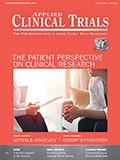The Road to True Patient Centricity
Applied Clinical Trials
Patient advocacy groups, patient centricity initiatives, and patient education are the key to putting patients at the center of clinical research.
Lisa Henderson

Putting patients at the center of clinical research is a continued challenge. Barriers to getting people more involved are numerous: lack of awareness, lack of health literacy and education, mistrust or desire, physician awareness or aptitude, lack of a cohesive healthcare to research pathway, lack of patient involvement in trial design, ability to find a trial, ability to adhere and stay motivated in a trial…all of these factors and more go into the overall challenge of patient centric initiatives. On the pharma R&D side, too often the focus on patients is a transactional one, solely to improve patient recruitment, which has proved ineffective and misguided. However, many positive initiatives exist in patient centricity, and this issue, along with the March issue of Pharm Exec, touches on some of them.
Moe Alsumidaie, a contributor to Applied Clinical Trials, regularly reports about patient centricity initiatives. In his article, he summarizes the advances since he began corresponding in 2014. He notes that the FDA suggested that industry wasn’t involving the patient during the entire drug development process, and that “the industry should focus on why they are bringing drugs to market, incorporating patient diversity, and generating outcomes meaningful to patients. FDA suspected the disconnect in patient centricity interpretations arose from C-suite level personnel within the biopharmaceutical industry.”
The need to involve patient advocacy groups as a way of gaining patient insight is a growing movement and one that is shifting from a transactional, less-involved relationship to one that is more strategic. However, that too faces a holistic patient view as a challenge when within sponsor companies themselves, the patient advocacy or patient-centric function can be divided between research and commercial. As Joel Beetsch, PhD, vice president of patient advocacy at Celgene, notes in a March article in Pharmaceutical Executive, “[Manufacturers] can have two different types of patient advocacy organizations. One might be in a center of excellence within their R&D community that is really working to recruit clinical trials. Then there’s a separate function that is more associated with the business. Often, those two functions within the same company don’t communicate regularly with one another.” And while this can be common practice, Beetsch says that is not the case at Celgene, where all of those activities are in one department.
Finally, patient education and awareness is another key piece missing in clinical research. In this issue, The Center for Information and Study on Clinical Research Participation (CISCRP) offers an analysis of the evolution of its own services to the patient community as a non-profit organization. At the end of the article, the authors note, “The objectives of awareness and clinical research literacy are no longer to primarily increase patient recruitment rates. They have evolved to accommodate patient needs to influence and be a part of each patient’s healthcare and treatment decisions; build confidence and a personal sense of control in one’s own health journey; enable key stakeholders to facilitate participations; to elevate appreciation for all study volunteers; and to demonstrate the personal relevance of clinical research participation.”
Lisa Henderson is Editor-in-Chief of Applied Clinical Trials. She can be reached at lhenderson@mmhgroup.com. Follow Lisa on Twitter: @trialsonline

Unlock Commercial Growth through Data-Driven Patient and HCP Insights
May 2nd 2025Leveraging data-driven patient and healthcare provider (HCP) insights, including social drivers of health (SDOH), is essential for life sciences companies to continuously improve patient engagement and commercial success. Mark Rodgers, AVP of Commercial Analytics at Inovalon, discusses how identifying treatment milestones, assessing HCP performance, and segmenting patient populations using SDOH data can drive targeted strategies that improve healthcare outcomes and market access
Improving Relationships and Diversifying the Site Selection Process
April 17th 2025In this episode of the Applied Clinical Trials Podcast, Liz Beatty, co-founder and chief strategy officer, Inato, discusses a number of topics around site engagement including community-based sites, the role of technology in improving site/sponsor relationships, how increased operational costs are impacting the industry, and more.
FDA Approves Nipocalimab for the Treatment of Generalized Myasthenia Gravis
April 30th 2025Approval is based on results from the pivotal Vivacity-MG3 trial in which IMAAVY (nipocalimab-aahu) demonstrated superior disease control throughout 24 weeks when compared to placebo plus standard of care.